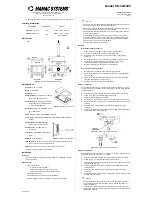
FT-2000
Operating Manual
Vertex Standard Co., Ltd.
53
future.
With reference to Figure (B), note the initial position (12 o’clock) of the [CONTOUR]
knob when the [CONTOUR] button is pushed. You may observe the “indentation” in
the receiver passband where the Contour filter is placing a low-Q “notch” (per the
setting of Menu item “089,” referenced above). Counter-clockwise rotation (to the left)
of the [CONTOUR] knob causes the indentation to move towered a lower frequency
within the passband, while clockwise rotation (to the right) causes the indentation to
move toward a higher frequency within the passband. By removing interference or
unwanted frequency components on the incoming signal, it is possible to make the
desired signal rise out of the background noise/interference, enhancing intelligibility.
Quick Point: The steep slopes of the DSP filtering can, when adjusted aggressively,
impart an unnatural sound to an incoming signal. Oftentimes, though, a narrow
bandwidth is not the key to improving copy; the incoming signal itself may have
undesirable or excessive frequency components, especially in the low-frequency range
around 400 Hz. By judicious use of the Contour filter, the “shoulder” of the passband
response may be altered, or components removed from within the passband, allowing
the desired signal to rise above the background noise and interference in a manner not
obtainable with other filtering systems.
IF SHIFT Operation (SSB/CW/RTTY/PKT/AM Modes)
IF Shift allows you to vary the DSP filter passband higher or lower, without changing
the pitch of the incoming signal, so as to reduce or eliminate interference. Because the
carrier tuning frequency is not varied, there is no need to re-tune the operating
frequency when eliminating the interference. The total passband tuning range for the
IF Shift system is ±1 kHz.
Rotate the [SHIFT] knob to the left or right to reduce the interference.
Advice:
The [SHIFT] knob effects to the Main band (VFO-A) only. However, you may shift
the Sub band (VFO-B) filter passband via Menu item “041 S-iF LSB SET” through
“048 S-iF PKT-USB.”
The position of the IF Shift can be observed on the display.
Referring to Figure (A), note the depiction of the IF DSP filter as the thick line, with
















































